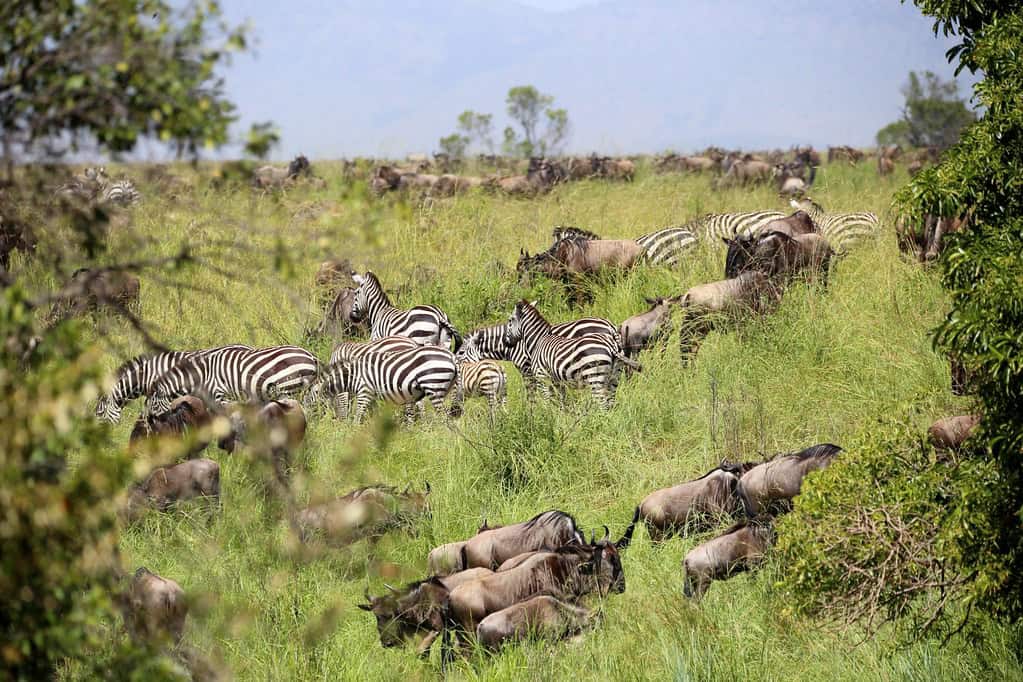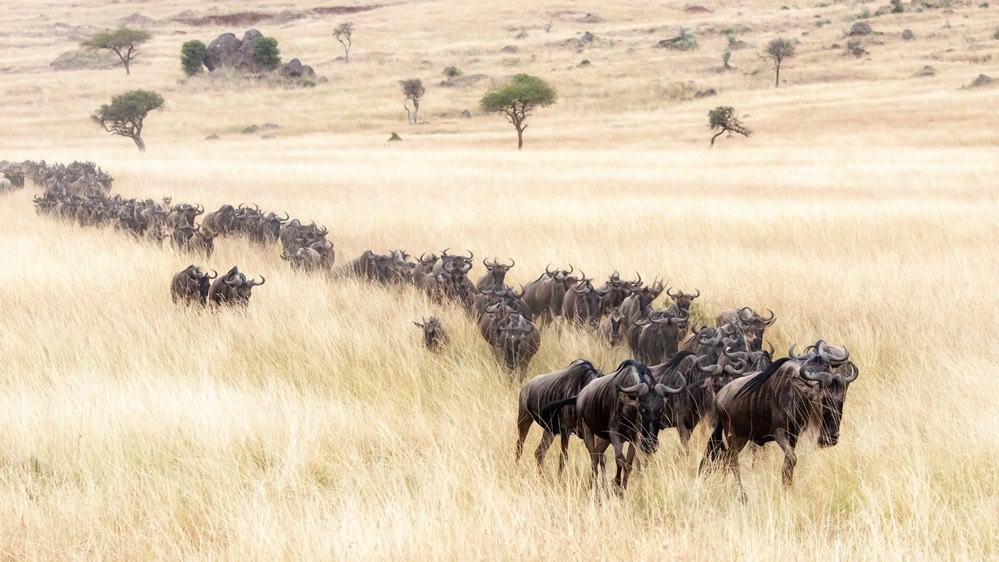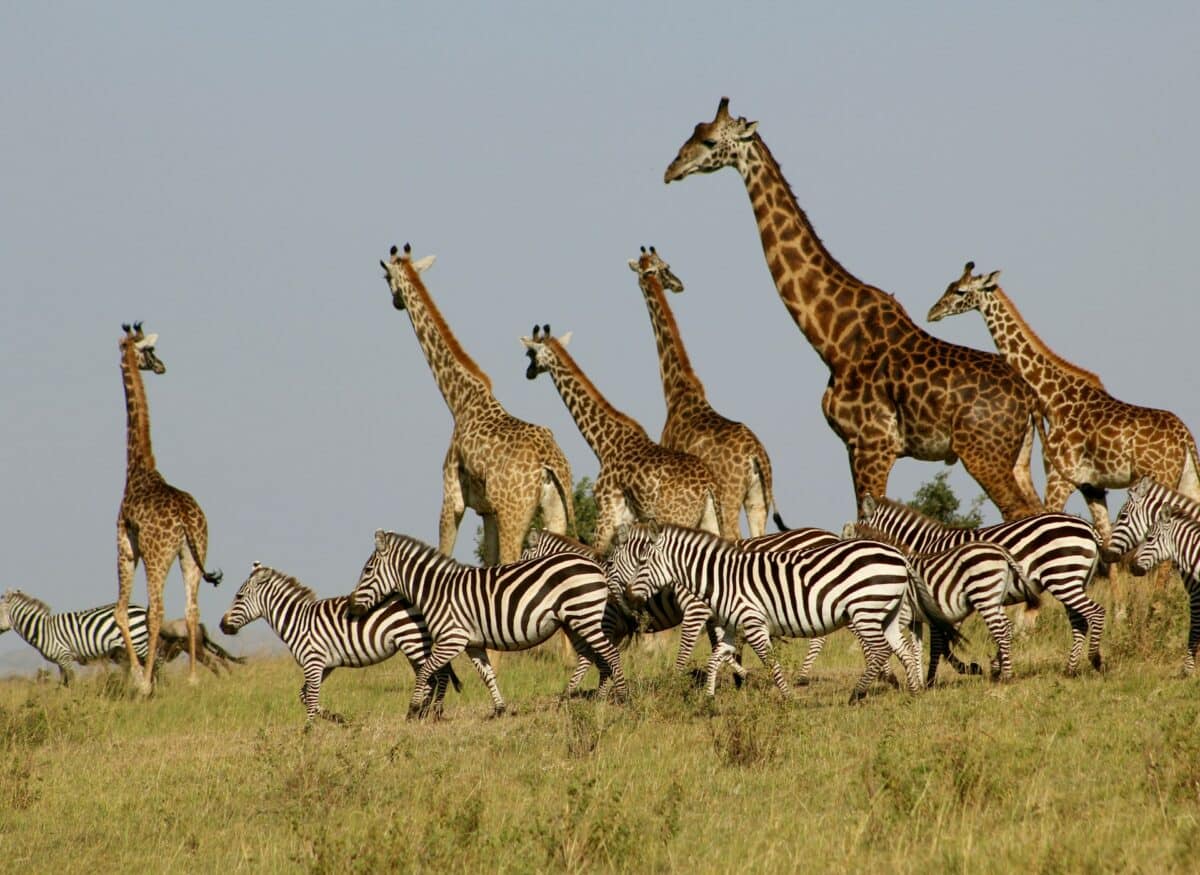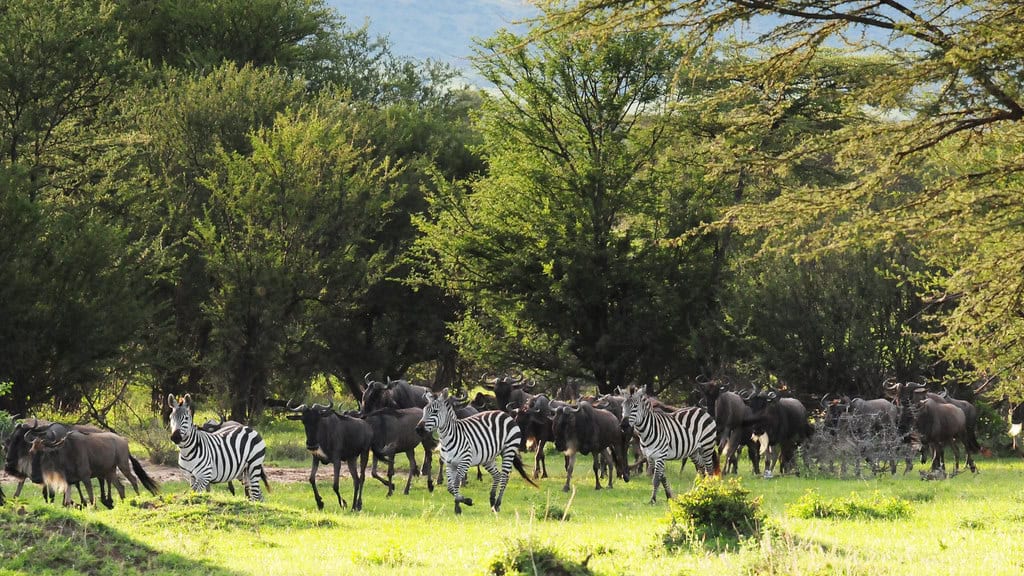In the vast savannas of Africa, one of nature’s most remarkable partnerships unfolds as zebras and wildebeest journey together across the landscape. This fascinating relationship between two different species represents one of the animal kingdom’s most successful collaborative ventures. While casual observers might assume these animals simply happen to share the same habitat, their association goes much deeper, involving mutual benefits that have evolved over thousands of years. The striped zebras and the more robust wildebeest have developed an interdependent relationship that helps both species survive in the challenging African wilderness. This article explores the fascinating dynamics of this relationship, examining why these animals choose to travel together and how their partnership benefits their survival in the wild.
The Great Migration: Nature’s Greatest Show

The most spectacular demonstration of the zebra-wildebeest partnership occurs during the Great Migration in East Africa. Each year, approximately 1.5 million wildebeest and 200,000 zebras, along with smaller numbers of gazelles and elands, make a circular journey of nearly 1,800 miles through Tanzania’s Serengeti National Park and Kenya’s Maasai Mara Reserve. This epic migration is driven by the search for fresh grazing and water sources as the seasonal rains move across the region. The wildebeest typically form the largest portion of this migrating mass, but zebras are always found among them, traveling in family groups that integrate with the larger herds. This natural phenomenon represents the largest terrestrial mammal migration on Earth and serves as the most visible evidence of the close association between these species.
Complementary Feeding Habits

One of the primary reasons zebras and wildebeest travel together involves their complementary feeding patterns. Zebras are bulk grazers that prefer to eat longer, tougher grasses that many other herbivores avoid. As they move through grasslands, they essentially “mow” the vegetation, removing the taller, coarser portions of grass plants. This feeding behavior exposes the shorter, more tender shoots and leaves that wildebeest prefer. Research has shown that areas grazed by zebras often see wildebeest arriving shortly afterward to take advantage of the more accessible vegetation. This relationship benefits both species—zebras get first access to abundant (if tougher) grass, while wildebeest gain easier access to the nutritious parts they prefer. This feeding synergy helps explain why these species are frequently found in close proximity.
Enhanced Predator Detection

Safety in numbers is a crucial survival strategy on the African plains, where predators like lions, hyenas, and crocodiles are constant threats. By traveling together, zebras and wildebeest create larger, mixed-species herds that offer improved predator detection capabilities. Zebras possess excellent eyesight and hearing, making them particularly adept at spotting danger from a distance. Wildebeest, meanwhile, have a keen sense of smell that complements the zebras’ visual vigilance. Together, these animals form a more effective early warning system than either species could maintain alone. When one animal detects a threat and reacts, the alarm quickly spreads throughout the mixed herd, giving all members a better chance of escaping predation. Studies have shown that mixed-species groups of herbivores typically detect predators faster than single-species groups, demonstrating the survival advantage of this arrangement.
Different Knowledge Base: Water and Food Resources

Zebras and wildebeest each possess specialized knowledge about their environment that, when combined, creates a more comprehensive understanding of available resources. Zebras have exceptional spatial memory and are known to remember migration routes and water source locations even after years of absence. They often lead the initial stages of migration movements, with wildebeest following their lead. Wildebeest, on the other hand, are particularly skilled at locating fresh grazing areas and can detect rainfall-stimulated grass growth from considerable distances. By traveling together, both species benefit from this pooled knowledge—zebras guide the herds to reliable water sources, while wildebeest help locate the best grazing opportunities. This complementary knowledge base increases the efficiency of resource acquisition for both species and represents another adaptive advantage of their association.
Distinct Physical Adaptations

The physical differences between zebras and wildebeest contribute to their successful partnership. Zebras, with their distinctive black and white striped coats, possess digestive systems adapted for processing lower-quality forage. Their powerful incisors can crop tough grasses close to the ground, and their hindgut fermentation system allows them to extract nutrients from fibrous vegetation that other animals cannot efficiently digest. Wildebeest, with their more specialized ruminant digestive systems, process vegetation more thoroughly but require higher-quality forage. Their blue-gray coats and distinctive horns create a different visual profile from zebras. When these physically distinct animals group together, the resulting mixed herd creates a more confusing visual target for predators, potentially disrupting their hunting strategies. The combination of different body sizes, shapes, and colorations in a mixed herd can make it more difficult for predators to focus on an individual target.
Predator Confusion and Dilution Effect

Beyond improved detection capabilities, traveling in mixed-species herds creates two additional anti-predator benefits: the confusion effect and the dilution effect. The confusion effect occurs when predators have difficulty focusing on a single target amid the visual chaos of a mixed herd with different species moving in various patterns. Lions and other predators typically select and track an individual prey animal before attacking, and this process becomes more challenging when faced with zebras and wildebeest moving together. The dilution effect is a simple mathematical advantage—with more animals in a group, each individual’s chance of being the one captured decreases. For both zebras and wildebeest, being part of a larger, mixed group reduces each animal’s statistical risk of predation. Research has demonstrated that predation rates per individual are typically lower in larger herds, providing a strong evolutionary incentive for these species to associate.
Seasonal Variations in Association

The strength of the zebra-wildebeest association varies seasonally, reflecting changing environmental conditions and reproductive cycles. During the dry season, when resources are scarce, these species tend to form closer and more consistent mixed herds. Water becomes a limiting factor, and both species congregate around remaining water sources, intensifying their association. During migration periods, particularly when crossing rivers where crocodiles pose a serious threat, the association also strengthens. However, during the wet season, when resources are more abundant and widely distributed, the groups may become less integrated, with family units spreading out more. Similarly, during calving season (typically synchronized for both species in the early wet season), the herds may temporarily separate, with wildebeest forming distinct calving grounds. These seasonal variations demonstrate the flexibility of the relationship, which intensifies when environmental pressures increase.
River Crossings: Dangerous Necessity

Perhaps the most dramatic moments in the zebra-wildebeest partnership occur during river crossings, particularly of the Mara River in Kenya and the Grumeti River in Tanzania. These crossings represent necessary but extremely dangerous passages where crocodiles and strong currents pose significant threats. Interestingly, research has documented that zebras often initiate these crossings, with wildebeest following once the zebras have established a safe passage. This behavior appears to benefit the wildebeest, who can observe where zebras successfully cross and avoid areas where crocodiles have captured zebras. However, once a crossing begins, the much more numerous wildebeest typically form the bulk of the crossing herd, which may benefit zebras by diluting their individual risk. These river crossings represent one of the most visually stunning examples of the risk-sharing aspects of the zebra-wildebeest relationship and are frequently captured in nature documentaries.
Shared Parasites and Disease Management

The close association between zebras and wildebeest extends to their interactions with parasites and diseases, creating another dimension to their relationship. Both species suffer from similar external parasites, particularly ticks, and traveling together may help reduce parasite loads through a process called “allogrooming” (mutual grooming). Additionally, studies have found that certain species-specific diseases can be less likely to spread rapidly in mixed-species herds compared to single-species groups. The mobility of these mixed herds also helps them escape areas with high parasite densities. Interestingly, zebras serve as hosts for African horse sickness but typically don’t develop severe symptoms, while they can transmit the disease to other equids. Wildebeest calves, meanwhile, carry wildebeest-associated malignant catarrhal fever, which can be fatal to cattle but doesn’t affect zebras. This disease resistance complementarity may be another factor supporting their association.
Behavioral Differences: Leaders and Followers

Observational studies of mixed zebra-wildebeest herds have revealed fascinating behavioral dynamics between the species. Zebras, particularly the lead mares of family groups, often take more decisive roles in initiating movement across novel or potentially dangerous terrain. Their curiosity and lower hesitation threshold may stem from their evolutionary history as prey animals that rely more on flight than fighting when threatened. Wildebeest, while also capable of rapid flight, show more hesitation when encountering novel situations but will quickly follow once zebras have demonstrated a path’s safety. This behavioral complementarity—with zebras serving as “pioneers” and wildebeest as “exploiters” of established paths—creates an effective division of risk-taking that benefits both species. The more cautious wildebeest reduce their exposure to unknown dangers, while zebras gain the safety advantages of being followed by large numbers of wildebeest, creating confusion for predators.
Human Impact on the Partnership

The zebra-wildebeest partnership faces increasing pressure from human activities that threaten their ability to maintain traditional migration patterns. Habitat fragmentation through fencing, agricultural expansion, and infrastructure development has interrupted migration corridors in many parts of Africa. Climate change also poses a significant threat by altering rainfall patterns that drive the timing and direction of migrations. Conservation efforts increasingly recognize the importance of preserving not just individual species but the ecological relationships between them. Several initiatives now focus on maintaining migration corridors and protecting the seasonal ranges that allow the zebra-wildebeest relationship to function naturally. The continued success of this partnership depends largely on human willingness to accommodate these ancient migration patterns and the ecological processes they support.
Conclusion: Nature’s Perfect Partnership

The zebra-wildebeest relationship represents one of nature’s most successful interspecies partnerships, demonstrating how different species can benefit from association without direct competition. Through complementary feeding strategies, enhanced predator detection, shared knowledge of resources, and mutual risk reduction, these animals have developed a relationship that increases survival chances for both species. This partnership has evolved over thousands of years and continues to play out across the African savannas, particularly during the spectacular Great Migration. As climate change and human development increasingly threaten traditional wildlife movement patterns, understanding and preserving such ecological relationships becomes ever more important. The zebra-wildebeest partnership serves as a powerful reminder that in nature, cooperation often proves as important as competition in the struggle for survival.
- How Rhinos Communicate Using Dung and Urine - August 9, 2025
- Why Nurse Sharks Are Often Misunderstood - August 9, 2025
- 9 Most Venomous Spiders Lurking in US Homes - August 9, 2025

